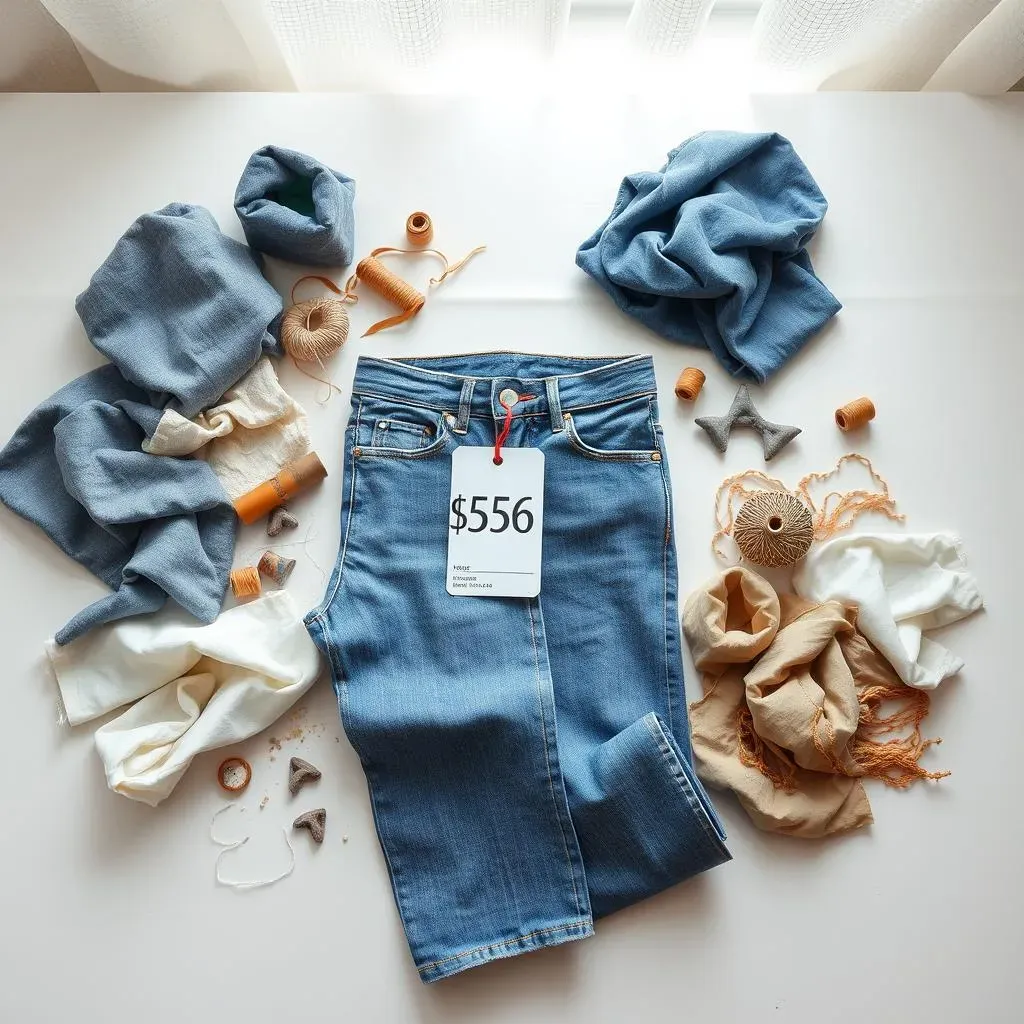Table of Contents
Ever felt lost in the maze of "cotton jeans pant price" tags? It's like navigating a jungle, with prices swinging wildly from one store to the next. I know, I've been there, staring at a rack of denim, wondering if I'm about to overpay for a pair of pants. But don't worry, I'm here to help you make sense of it all. This isn't just about finding the cheapest jeans; it's about understanding what you're paying for. We'll explore the different things that affect the price of cotton jeans, from the type of cotton used to the brand name on the label. I'll also guide you to the best places to score a deal, and finally, we'll look at how different styles can impact the final price. So, get ready to become a savvy shopper, and let’s find that perfect pair of cotton jeans without emptying your wallet.
Factors Influencing Cotton Jeans Pant Price

Factors Influencing Cotton Jeans Pant Price
The Cotton Itself: Not All Fibers Are Created Equal
Okay, so you're staring at two pairs of jeans, both claiming to be "100% cotton," but one costs twice as much? What gives? Well, the type of cotton makes a huge difference. Think of it like apples – you've got your basic Red Delicious, and then you've got fancy Honeycrisps. Similarly, with cotton, you have different grades and types. Long-staple cotton, like Egyptian or Pima, is known for being softer and more durable, which means it's going to cost more. Regular cotton, while perfectly fine, isn't going to have that same luxurious feel or longevity. The way the cotton is grown and harvested also plays a role, with organic and sustainable options often carrying a higher price tag.
The Making of the Jeans: From Fabric to Fit
It's not just the cotton itself; the way it's turned into jeans also affects the price. The process of turning raw cotton into fabric, and then into jeans, involves many steps. If a jean is made in a country with higher labor costs, that will add to the price. Also, consider the details: is it a basic five-pocket style, or does it have special washes, distressing, or unique stitching? These extra design elements and treatments add to the production cost, which then gets passed on to you, the shopper. The more intricate the design and the more care that goes into the manufacturing, the higher the price tag.
Factor | Impact on Price |
|---|---|
Type of Cotton (e.g., Pima, Organic) | Higher Price |
Manufacturing Location | Varies, higher labor costs increase price |
Design Complexity | Higher Price |
Brand Name | Higher Price (often) |
Where to Find the Best Cotton Jeans Pant Price Deals

Where to Find the Best Cotton Jeans Pant Price Deals
Online Marketplaces: Your Digital Treasure Trove
Alright, let's talk about where to actually snag those deals. Online marketplaces like Amazon, Flipkart, and even eBay can be goldmines for discounted cotton jeans. The key here is to be patient and do your research. Look for sellers with good ratings, read customer reviews, and don't be afraid to compare prices across different listings. Many of these sites have filters that allow you to sort by price, making it easier to find the best deals. Plus, keep an eye out for those flash sales and promotional events – they can be your secret weapon for getting killer discounts. But remember, always double check the seller's return policy before you click that "buy" button!
Department Stores and Brand Outlets: The Sale Section Saviors
Don't count out the classic department stores and brand outlets. They often have amazing sales sections where you can find quality cotton jeans at reduced prices. I'm talking about places like Macy's, Nordstrom Rack, or even the outlet stores for brands like Levi's or Gap. These places can be a little more hit-or-miss than online marketplaces, but when you find a deal, it's often worth it. I have a pro tip: visit these places during off-peak hours. You'll have more time to browse, and the staff might be more helpful. Also, signing up for their email lists can get you access to exclusive coupons and early sale notifications.
Shopping Location | Pros | Cons |
|---|---|---|
Online Marketplaces | Wide Selection, Easy Price Comparison, Frequent Sales | Seller Reliability Varies, Return Process Can Be Complex |
Department Stores & Outlets | Opportunity to try on, Potential for good sales, Reliable returns | Can be hit or miss, selection can be limited |
Secondhand Stores | Very affordable, Sustainable option, unique finds | Requires patience, condition may vary |
Secondhand Shops: Hidden Gems and Sustainable Savings
Finally, let's not forget about the treasure trove that is secondhand shops. Places like Goodwill, Salvation Army, or even online consignment stores can hold amazing deals on cotton jeans. You might have to dig around a bit, but the prices are often unbeatable, and it's a more sustainable way to shop. Plus, you never know when you'll find a vintage or designer pair at a fraction of the cost. I once found a pair of barely worn Levis for five bucks! It's all about patience and a keen eye. So, if you're up for a bit of a treasure hunt, secondhand stores are definitely worth checking out.
Understanding Different Cotton Jeans Pant Styles and Their Prices

Understanding Different Cotton Jeans Pant Styles and Their Prices
The Classic Straight Leg: Your Reliable Go-To
Let's start with the straight leg, the workhorse of the denim world. This is your classic, no-fuss style, and it tends to be one of the more affordable options. It's got a consistent width from the hip down to the ankle. Because it is a simple design, it doesn't usually require a lot of extra manufacturing steps, which keeps the cost down. Think of it as the basic model – it does the job well, and it's not trying to be anything it's not. You can often find great deals on straight-leg jeans because they are so widely produced. They are also versatile, pairing well with almost any type of top or shoe. It's a great place to start if you are building your wardrobe and need something dependable.
Skinny Jeans vs. Relaxed Fit: A Matter of Style and Price
Now, let's talk about two styles on opposite ends of the spectrum: skinny and relaxed fits. Skinny jeans, with their tight fit from hip to ankle, often come with a slightly higher price tag. This is because they sometimes use stretch fabrics and require more intricate tailoring to achieve that super-slim silhouette. Relaxed-fit jeans, on the other hand, are looser and more forgiving. They often have a wider leg and are generally less expensive than skinny jeans. The looser fit means less fabric waste and less detailed construction. So, if you're looking to save some cash, a relaxed fit can be a great choice. But remember, the fit is mostly about personal preference, so don't let the price be the only deciding factor.
Style | Fit | Price Range | Typical Features |
|---|---|---|---|
Straight Leg | Consistent width from hip to ankle | Low to Mid | Simple design, versatile |
Skinny | Tight from hip to ankle | Mid to High | Often uses stretch fabrics, more tailored |
Relaxed Fit | Loose and comfortable | Low to Mid | Wider leg, less tailored |
Bootcut | Slight flare at the ankle | Mid | Wider leg opening, good for boots |
Bootcut and Beyond: Exploring Specialty Styles
Finally, let's look at some specialty styles, like bootcut and wide-leg jeans. Bootcut jeans, with their slight flare at the ankle, are usually priced in the mid-range. The flare adds a touch of style without being too extreme. Wide-leg jeans, on the other hand, can vary quite a bit in price depending on the fabric and design. Some might be basic and affordable, while others, with special washes or unique features, can be more expensive. These styles often require more fabric and careful construction, which impacts their final price. Keep in mind that trends come and go, so while a trendy style might be pricier now, it could be on sale later. The key is to think about what styles work best for you and your budget. Don't be afraid to try on different styles and see what you like. After all, the best pair of jeans is the one that you feel good in.
